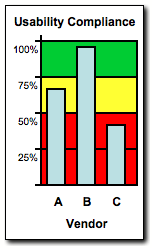|
|

|
Developing a Method of Monitoring Vendor User Experience
Overview
When vendors provide product that will end up in a customer's hands, it is important to hold the vendor to some baseline measure of a good user experience. The goal of this project was to provide the vendor with usability feedback, including a usability compliance score, as part of a greater vendor assessment project already in place. Key questions that drove the usability assessment score included:
- Was the design delivered as specified?
- Was the design delivered in good working order, or were there bugs in the software?
- Were problems fixed quickly?
- Were important user experience issues fixed, or did they remain secondary fixes to what were deemed as less important functional fixes?
- Did the product meet usability standards as defined by the parent company, and as exhibited by target segment uesrs in usability testing?
Accomplishments

Working collaboratively with another team member, we designed a vendor usability assessment score. The graph below is an example of a calculation that is made as a function of one of the subitems that contribute to the overall score. There are two items of note:
- The general idea shows that the score accounts for higher scores when there are fewer problems, and a lower score when there are more problems.
- Additionally, the curve function allows for higher scores when the number of problems is within the projected workload expected for the product, and lower for when more work is required than expected. This function can be changed over time to match workload expectations and changes in the norm of problem issue distribution.

Building on That

This type of score certainly requires another level of thought. The goal of the score of course is to bring the vendors into compliance while still understanding that the company itself may be responsible for some of the issues. The following are other thoughts that drove the final score calculations.
- Was the vendor delivering new technology, or an evolution on an existing product?
- Did the vendor deliver well before functional testing so that the company could work out issues early, or did the vendor deliver just in time, or even late, making changes to the product more difficult and costly?
- Is a particular usability or feature design issue more critical to the user experience than another?
- Do the issues that does not meet compliance belong to the vendor, the company, or a third party?
- How does the company ensure that it stays responsible and accountable for its part in the problem issues?
Skills

- User experience score design
- Assessment of the score's business impact on the vendor, which could ultimately lead to dismissing the vendor
Back to Portfolio Highlights
|
More...
Leading UX Research and Design
|


